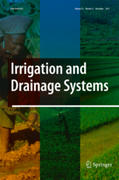Limits to agricultural growth in the Sistan Closed Inland Delta, Iran
Van Beek, Eelco / Babak Bozorgy / Zoltan Vekerdy / Karen MeijerExternal Publications (2008)
in: Irrigation and Drainage Systems 22 (2), 131-143
The Sistan Delta in Iran is located at the end of a closed basin with nearly 100% of the supply coming from Afghanistan. This supply is supporting irrigated agriculture in the area and is the source for the lake system around the delta. These Hamoun lakes are ecological very valuable wetlands; a number of them are registered as Ramsar sites. The Iranian government tries to improve the living conditions of the people in the area, among others by providing infrastructure for irrigated agriculture. Further development of the irrigated area will mean less water for the Hamouns with resulting lower average water coverage of the lakes. This will not only endanger the ecosystem that the Hamouns support but also the livelihoods of the people that depend on the goods and services that the lakes provide. This paper describes a study that has been carried out to support decision making on potential development schemes in the delta. The non-availability of data from Afghanistan requires the development of various tools and the use of remote sensing techniques to enable to make estimates for the river flow that Iran can expect from Afghanistan. An IWRM approach has been used for the balancing of interests involved. Some preliminary conclusions are described.

